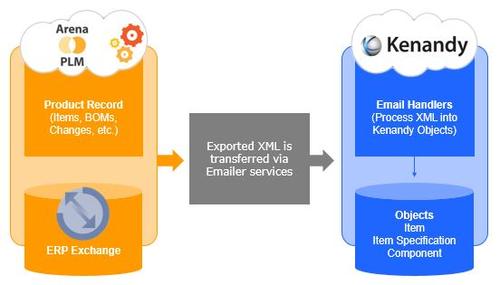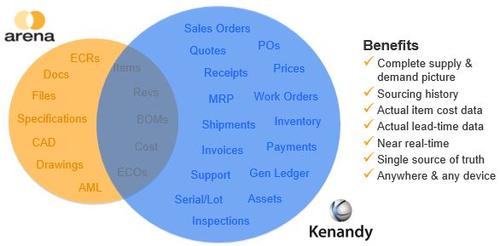Arena Solutions notes that its cloud PLM has integrated into Kenandy's cloud ERP with a seamless handshake.
January 18, 2016
Cloud-based product lifecycle management (PLM) company, Arena Solutions, has created seamless integration with Kenandy Cloud ERP, a cloud-based enterprise software company. The integrated pathways are available to all Arena and Kenandy customers. The digital handshake was prompted by one mutual customer, Primus Power, an energy storage company that was using Arena for design and engineering activities while also using Kenandy ERP. “Customers brought us together," Rod Butters, COO and president of Kenandy told Design News. “We listened to the market and they spoke loudly.”
(Source: Arena Solutions)
The goal of the integration was to manage the product development process of product data, including design files, bill of materials, and manufacturer and supplier data. The data is centralized in the Arena PLM system through the entire product lifecycle process, and it’s then integrated into Kenandy ERP for planning, procurement, and manufacturing. There is also visibility on both sides through the entire process.
Speed to Market Is Money Saved
The ability to move smoothly and quickly from design to manufacturing is the highest value in the integration, according to Arena. “What Arena has done with Kenandy is push the data from engineering to execution through a cloud system. The goal is to create a seamless flow of data from engineering PLM to execution,” Steve Chalgren, EVP of project management at Arena, told us. “If the flow isn’t there, it slows the company’s ability to execute, which slows down the ability to deliver product.”
The purpose of the integration is to make the handoff of data from PLM to ERP virtually real-time. The payoff is the instant shift from product design to planning and manufacturing. “Execution is getting the product into the supply chain and into manufacturing and out the door. Getting the BOM into the ERP system is a prerequisite,” said Butters.
[Learn more PLM developments at Pacific Design & Manufacturing, Feb. 9-11, at the Anaheim Convention Center.]
Butters noted that the integration between PLM and ERP also offers critical visability between design and execution. Design needs visibility even after the product is handed off to the ERP system. “Design engineers need visability into the production process because they may be involved in prototypes, change orders, or improvements. Or they may be dealing with a defect.” He explained that the integration reduces costs, but the reason for deploying it is the ability to speed the design-to-market process. “It is a cost saver, but what’s driving the decision is getting to market much faster. Even if costs were equal, the visability and the ability to bring a product out faster are the important factors,” said Butters.
Cloud-Cloud Connections
Another advantage of the integration is that both Arena and Kenandy offer a cloud-based solution. “We’re a cloud company. When integrated with Kenandy ERP, it was cloud-to-cloud, making the integration simpler,” said Chalgren. “We designed an integration tool so our customers don‘t have to manage some complex middleware.”
(Source: Arena Solutions)
Butters agreed that the integration goes smoothly, even when legacy systems are involved. “The integration is easy. We’ve had no calls,” he said. “When you cobble together systems, it usually takes a lot of care and feeding. Since it’s a cloud-to-cloud integration, it has been trouble-free for our customers.”
The Case for Cloud Security
Security is always an issue when your data resides on an outside server. Butters noted that many of Kenandy’s customers put the cloud ERP through security analysis. “We have customers with the resources to go through thorough analysis, which they are required to do,” he said. “We go through very extensive audit for security and internal control.” He notes that cloud security has grown up over the years and that it has been deployed by global companies. “We have proof we can meet the security requirements. Companies have learned the hard way that cloud vendors are much more sophisticated with security than their internal systems are.”
READ MORE ARTICLES ON INTEGRATED SYSTEMS:
Arena also asserts its security is superior to the internal security of its customers. “Companies have become comfortable with the cloud. They have developed teams to do audits,” said Chalgren. “When they go through the audit process, they realize their own IT staff is not equal to the task. When you’re a cloud company, you have dedicated teams for security.”
One of the security tactics is to make sure no one person has access to the entire collection of data. At Arena PLM we have split sourcing so people only have pieces of the system, not the whole process,” Kent Killmer, VP of marketing at Arena told Design News. “If an employee becomes disgruntled, he won’t have the access to the company’s crown jewels.”
Rob Spiegel has covered automation and control for 15 years, 12 of them for Design News. Other topics he has covered include supply chain technology, alternative energy, and cyber security. For 10 years he was owner and publisher of the food magazine Chile Pepper.
Like reading Design News? Then have our content delivered to your inbox every day by registering with DesignNews.com and signing up for Design News Daily plus our other e-newsletters. Register here!
About the Author(s)
You May Also Like







